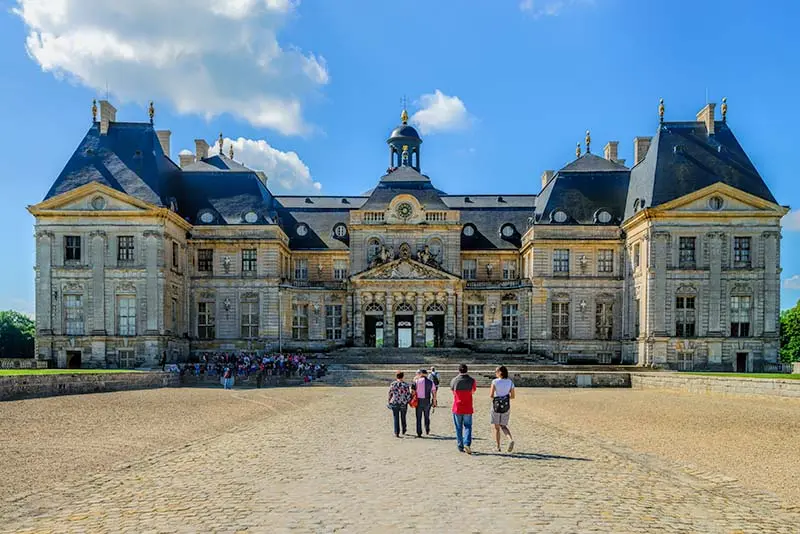The Men of Vaux le Vicomte
In the 17th century, four men – financier Nicolas Fouquet, architect Louis Le Vau, landscaper André Le Nôtre and painter Charles Le Brun combined to build one of France’s great estates, the Château de Vaux le Vicomte. Individually, these men were at the top of their game and well-respected in their profession. Their creativity at Vaux le Vicomte inspired the style of France’s great homes for over a century.
Nicolas Fouquet
Nicolas Fouquet, the financial superintendent to Louis XIV, was the man with the vision and the money who brought these creative geniuses together to build a great home fitting his status.
Born into a noble family, Nicolas Fouquet rose rapidly through the Court ranks thanks to his intelligence and loyalty to the royal family.
Consistent with his family’s emblem, the squirrel, and motto Quo non ascendet (To which heights will he not scale), Nicolas was appointed Superintendent of Finances at 38.

Two opposing views exist on how Nicolas Fouquet obtained the land upon which he built Vaux le Vicomte. The first view believes that he inherited the land around 1640 when his father died. The second view states he used his position as Superintendent of Finances to purchase the land and design and build Vaux le Vicomte.
However, he acquired his wealth not by looting the State’s coffers but by taking advantage of the intricate financial system of the day to amass a considerable fortune. He mainly owed his fortune to his marriage, investments and various offices.
A great patron of the arts, Fouquet provided financial support to artists of all persuasions, including La Fontaine, Molière, Corneille and Charles Perrault. In return for Fouquet’s favour, La Fontaine and Molière contributed music, ballet and a theatre play to Vaux le Vicomte’s opening celebration on August 17th, 1661.
Through his brother Louis, a priest in Rome, Fouquet also acquired many works of art, including three paintings by Veronese and several pieces by Nicolas Poussin. Paintings, sculptures, tapestries and unique Italian furniture all contributed to making Vaux le Vicomte a bastion of art in France, leading some to suggest that Fouquet virtually replaced King Louis XIV as France’s leading patron.

There is no doubt that Fouquet had acquired vast wealth. However, he did not choose the best of times to build Vaux le Vicomte, and he ignored all suspicions in the Court. Rebellion and intrigue plagued France, and his enemies were eager to discredit him.
But, Fouquet enjoyed the protection of the First Minister, the powerful Cardinal Mazarin. To aid Mazarin, Fouquet lent considerable sums to the treasury, making himself, in effect, a banker to the King. His numerous financial operations, which he conducted irregularly (though not contrary to the period), made him extremely rich.

After Mazarin’s death (March 1661), Jean-Baptiste Colbert, Mazarin’s assistant, sought to succeed Fouquet as finance minister by destroying his reputation with the King. Colbert revealed irregularities in Fouquet’s accounts and denounced the financial operations by which he had enriched himself.
Although Fouquet’s financial indiscretions were not significantly different from Mazarin before him or Colbert after him, his ambition worried Louis XIV. Fouquet appeared eager to succeed Mazarin, and he indiscreetly purchased and privately fortified the remote island of Belle Île.
Another concern for Louis XIV was Fouquet’s religious affiliations. Fouquet and his family were closely aligned with the Catholic movement, the Compagnie du Saint-Sacrément. Mazarin considered this movement among his fiercest opponents, and one of his last acts before his death was to persuade Louis XIV to ban the Compagnie du Saint-Sacrément in 1660.

So, by the time Fouquet threw his famous party on August 17th, 1661, to celebrate the completion of work at Vaux le Vicomte, the cards were pretty much stacked against him.
Three thousand people were invited, including the 22-year-old King Louis XIV. There were fireworks and fountains and even a specially commissioned play and a ballet. It was a triumph, except for one thing. Vau le Vicomte was an estate whose scale made it seem like a provocative political act. The celebration was a statement of power and wealth. And that fact proved to be Fouquet’s undoing.
The King was beside himself at the arrogance of Fouquet, showing that he was more affluent and potentially more powerful than himself. And just a few weeks later, he had Fouquet arrested by d’Artagnan, captain of the King’s Guard.

Fouquet’s trial for embezzlement and treason lasted three years and excited great public interest. Colbert suppressed the papers that would have proved Mazarin’s responsibility for many of the financial transactions in question. Ultimately, the King won out, and Fouquet served the rest of his life in prison.
Now, Louis XIV didn’t stop there. Not only did he get rid of Fouquet, he then proceeded to take everything from Vaux le Vicomte that everyone had admired so much. The King took statues, paintings, tapestries and furniture. He even took the orange trees. And above all, he took the designers Le Nôtre, Le Brun and Le Vau. He aimed to replicate Vaux le Vicomte at Versailles, but even better and more prominent.
But Fouquet’s legacy remains today. The buildings, sculptures, furniture, paintings, gardens and other embellishments conform to his wishes and tastes. He was not content to be treated as a source of money. He had sufficient confidence in his artistic ability to direct the activities of those who enjoyed his patronage.
André Le Nôtre (1613-1700)
André Le Nôtre followed his father as Royal gardener at the Tuileries in Paris, where he worked for twenty years before receiving his first commission at Vaux le Vicomte.

With his knowledge of mathematics, scale, and anamorphosis, Le Nôtre created grand illusions. He also painted and mixed with a group of sophisticated and creative people. So by the time Fouquet called him to Vaux le Vicomte, he was ready.
Fouquet asked Le Nôtre to do something impressive and radical. The result was a garden with a single great axis that ran unbroken from the château’s entrance to the far horizon.
Le Nôtre’s big idea was to cut through the landscape on a scale that no one else had ever imagined, creating the impression of the garden reaching the horizon.


Vast vistas replaced the protected intimacy of a Renaissance garden. Instead of a haven, this garden was about scale and ambition, presided over by a giant, brooding Hercules.
The work at Vaux le Vicomte was a massive undertaking from the start. The land did not seem promising. The only thing that seemed promising was Fouquet’s attitude, imagination and ambition.
Admittedly, Le Nôtre had Fouquet’s limitless fortune and an army of 18,000 men to carve out the landscape. Le Nôtre and his army swept away 190 acres of farmland, a village and two hamlets and diverted a river.
Along with the extensive demolition of the villages, Le Nôtre created canals, moved large rocks, built ramparts, and excavated a vast amount of soil to change the ground and its levels.
And, beneath the garden, there were also half a dozen water reservoirs, ingeniously engineered to feed the fountains, and all done by gravity.

At first glance, everything seems wholly ordered and symmetrical, but in fact, it’s not symmetrical. As you look, there are differences on either side. But what it is, is harmonious and balanced.
Le Nôtre broke the mould at Vaux by the scale and effortless ease with how the garden opens to the visitor. Carefully judged changes in level meant the pools, cascades, and the canal that bisects the site gradually reveal themselves as you walk through.
Louis Le Vau (1612-1670)
Louis Le Vau grew up in humble surroundings. His grandfather was a farrier, and his father was a stonemason. Essentially self-taught, Le Vau gradually built a reputation with perseverance and study.

By 1639, he was a successful architect. His interests centred on developing Île Saint-Louis as a residential area. There he designed mansions for several wealthy patrons, including the Hôtel Lambert.
Fouquet’s invitation to Le Vau in 1653 came quickly on the heels of the latter’s appointment as Principal Architect to the King.
By the time Le Vau reached Vaux le Vicomte, a large part of the garden was in place, with the first land acquisitions in 1641.
Influenced by Italian classical architecture, Le Vau created a building characterised by large curved forms, twisted columns, high domes, and complicated shapes.

He was concerned with creating an impressive visual effect that matched the scale of the whole estate.
Rather than place the rooms on top of each other, Le Vau put them next to each other, doubling the building’s width. The size of the framework ruled out the typical high, straight roof. Instead, he chose to use a hipped roof with an elliptical dome. The overall effect is an imposing structure that stands as the centre-piece of the whole estate yet is not an obstacle to viewing the gardens.
Later in Versailles, Le Vau designed the broad outlines of the conversion that turned a simple hunting lodge into the permanent residence of the Court.
Charles le Brun (1619-1690)
A friend of Le Nôtre since they studied architecture and painting together in Simon Vouet’s studios at the Louvre, Charles Le Brun later studied in Rome in the company of Poussin.

Upon returning to Paris, he painted at the easel and decorated large spaces like the Hôtel Lambert.
Fouquet commissioned Le Brun to oversee the decoration of Vaux le Vicomte. He designed furniture and statues, ran the tapestry factory in Maincy, and enlisted the help of his students and apprentices to paint the Château decorations, keeping the most critical elements for himself.
He did not have time to paint the dome of the Salon, the Palais du Soleil, a work of art on a scale never seen before in French art history.

After Fouquet’s fall from grace, Le Brun became a protégé of Colbert and Louis XIV.
Appointed as Principal Painter of the King, Director of Les Gobelins and Chancellor of the Academy in 1665, he oversaw the decoration of Versailles and, until Colbert’s death, imposed a virtual dictatorship on the French art world.
Post-1661
Nicolas Fouquet had wisely put the Château in his wife’s name, but it took her ten years to recover the property. She lived at Vau le Vicomte with her son until he died in 1705, when she sold it.
The Château then moved through the hands of several owners who provided variable attention to its maintenance.
In a state of disrepair, with the garden all but a distant memory, Vaux le Vicomte was acquired at auction in July 1875 by Alfred Sommier.
He began large-scale restoration work, which returned the estate to its original condition. His direct descendants continue that work today.
Practical Information
77950 Maincy,France
+33 1 64 14 41 90
[email protected]
Open everyday from 11am to 5:30 pm (closed Jan-Mar). Check web site for seasonal variations.
Car: A4 or A6 (1 hr); Train: Gare de Lyon to Melon (30 min) then taxi or shuttle bus; Coach: PARISCityVISION
www.vaux-le-vicomte.com/en/







